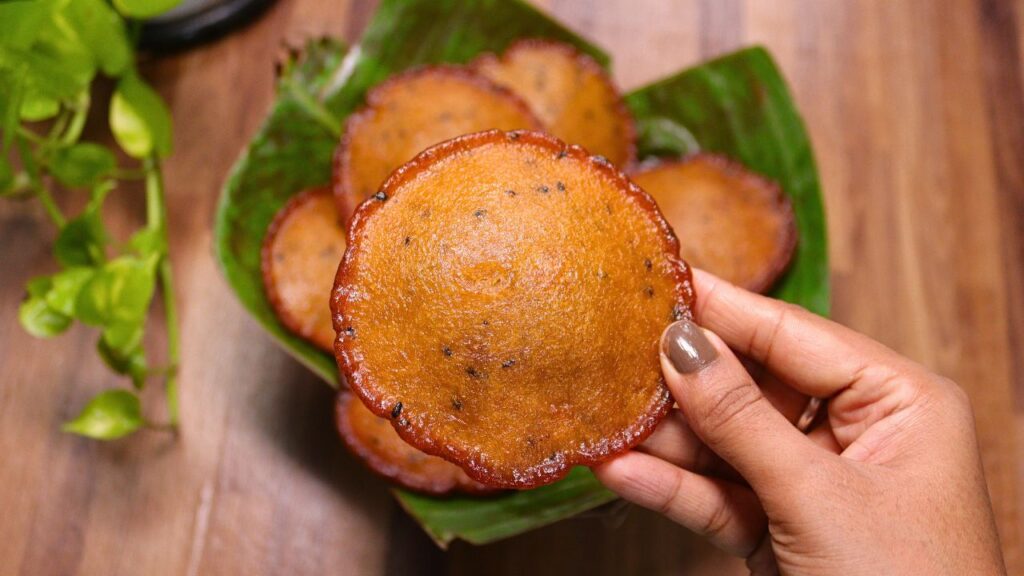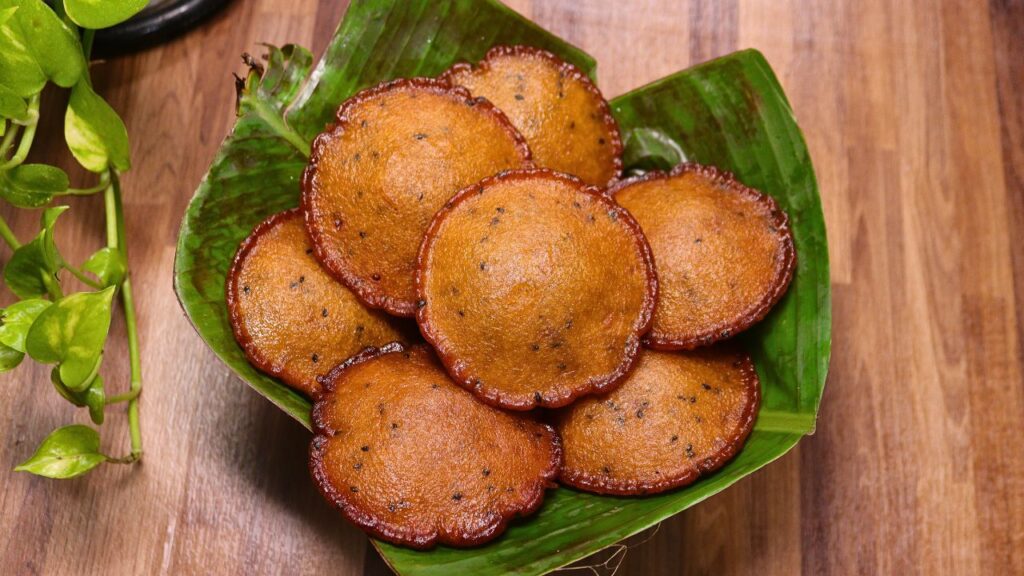



Neyyappam, a sweet and flavorful rice-based fritter, holds a special place in Kerala’s culinary tradition. The name “Neyyappam” is derived from two Malayalam words: "neyy" (meaning ghee or clarified butter) and "appam" (a general term for any type of pancake or fritter). This is not just a snack; it is a symbol of Kerala’s rich heritage, often associated with festivals, religious ceremonies, and cherished family moments. The intricate preparation of this snack reflects the age-old traditions passed down through generations, making it a quintessential part of Kerala’s cultural fabric.

Neyyappam is deeply intertwined with Kerala’s religious traditions, particularly in Hindu households. It is frequently prepared as an offering (prasadam) to the deity during temple festivals and special poojas. Neyyappam is most famously offered in temples dedicated to Lord Ayyappa, the revered Hindu deity worshipped primarily in Kerala and Tamil Nadu. Sabarimala, one of the most famous temples of Lord Ayyappa, has Neyyappam as a significant prasadam distributed to devotees.
The act of offering this snack in temples is symbolic, representing purity and devotion. Made with simple ingredients like rice, jaggery, and ghee, the sweet fritter becomes a spiritual offering, reflecting the simplicity and wholesomeness of life. The use of jaggery, which is considered auspicious, along with ghee, believed to enhance the purity of the offering, further elevates its importance in religious ceremonies.
Apart from temple rituals, this snack plays a key role during Vishu, the Malayali New Year, and other regional festivals like Onam and Thiruvathira. During Vishu, Neyyappam is often part of the festive spread, symbolizing prosperity, joy, and abundance. The tradition of preparing Neyyappam during these festivals has been passed down through generations, making it a nostalgic delicacy that evokes memories of festive joy and family togetherness.
The beauty of this snack lies in its simplicity, with just a handful of ingredients combining to create a rich, flavorful snack. These ingredients are not only delicious but also nourishing, making the snack a wholesome treat for any occasion.
Rice is the foundation of this snack, and the type of rice used plays a significant role in the final texture of the dish. Idli rice is commonly chosen due to its starchy nature, which provides a soft and slightly chewy consistency. The rice is soaked for several hours, ensuring it grinds smoothly into a batter. The grainy nature of the rice batter gives Neyyappam its characteristic texture, where each bite is soft yet firm, with a slight crispiness on the outside.
Jaggery is the key sweetener in this snack and is responsible for its deep, caramel-like flavor. Made from sugarcane or palm sap, jaggery is a healthier alternative to refined sugar as it retains more nutrients. The natural sweetness of jaggery is less sharp than that of white sugar, giving Neyyappam a more rounded and rich sweetness.
Melted jaggery, when mixed with the rice batter, imparts a lovely dark brown color to the Neyyappam, adding to its visual appeal. The earthy, molasses-like notes of jaggery also complement the subtle spice of the cardamom and the nuttiness of the sesame seeds used in the batter.
Ghee, or clarified butter, is a central ingredient in Neyyappam, both in the batter and in the frying process. Ghee gives Neyyappam its signature richness and buttery aroma. It also enhances the texture, helping the fritters develop a crisp outer layer while keeping the insides moist. The nutty flavor of ghee elevates the overall taste of Neyyappam, adding depth to the sweetness of the jaggery and the fragrance of the cardamom.
While traditionally Neyyappam is fried in oil, the use of ghee for frying can result in a more decadent snack with a richer flavor profile. Some cooks also add ghee to the batter to ensure that the Neyyappam remains soft and moist on the inside, even after frying.
Coconut is often included in Neyyappam, either as grated coconut mixed into the batter or as small slices fried in ghee. The addition of coconut brings a hint of natural sweetness and a bit of texture to the Neyyappam, complementing the other flavors in the dish.
Coconut slices are typically fried until golden in ghee, then added to the batter. This not only adds a delightful crunch but also infuses the batter with a toasted coconut flavor. The combination of coconut and ghee is a classic pairing in South Indian cuisine, and in Neyyappam, it creates a burst of flavor with each bite.
Black sesame seeds, though used sparingly, are an important component of Neyyappam. They lend a slight crunch and a nutty flavor, contrasting nicely with the softness of the batter. Sesame seeds also provide a visually appealing garnish, with their tiny black specks standing out against the golden-brown Neyyappam.
Sesame seeds are known for their high nutritional value, being rich in healthy fats, calcium, and antioxidants. While their flavor is subtle, their presence in Neyyappam adds a layer of complexity, making the fritter more interesting both in taste and texture.
Spices like cardamom and cumin seeds are often added to the Neyyappam batter to enhance its flavor. Cardamom, with its sweet and aromatic profile, complements the jaggery and ghee, adding a fragrant note that lifts the overall taste of the Neyyappam. Cumin seeds, on the other hand, provide an earthy, slightly spicy flavor, which adds a surprising twist to the sweetness of the dish.
Neyyappam is known for its combination of textures, with a crispy, golden-brown exterior that gives way to a soft, chewy interior. The use of rice flour ensures that the fritter remains light and not overly dense, while the jaggery gives it a rich, caramel-like sweetness. The crispy edges, especially when fried in ghee, provide a satisfying contrast to the tender, moist center.
The flavor of Neyyappam is complex, with the sweet, earthy taste of jaggery being balanced by the nutty sesame seeds, aromatic cardamom, and toasted coconut. The spices, though subtle, add depth to the sweetness, preventing it from being overwhelming. The ghee adds a luxurious richness, making each bite of Neyyappam feel indulgent.
While Neyyappam is undoubtedly a sweet treat, it is also quite nutritious. The use of rice and jaggery makes it a source of energy, while the ghee provides healthy fats. Sesame seeds and coconut add additional nutrients, including calcium, fiber, and essential fatty acids.
Jaggery is particularly valued for its health benefits, as it is rich in iron and minerals. Unlike refined sugar, which is empty in terms of nutrition, jaggery provides a more wholesome sweetness, making Neyyappam a slightly healthier alternative to other sugary snacks.
Over time, different variations of Neyyappam have emerged, depending on regional preferences and personal tastes. Some versions of Neyyappam include mashed bananas, which give the fritters a softer, more moist texture and an additional layer of natural sweetness. The banana variation is particularly popular with children, as it adds a familiar fruity flavor to the snack.
Other variations include the addition of dried fruits like raisins or cashews, which are often fried in ghee and mixed into the batter. These ingredients add both texture and flavor, making the Neyyappam even more indulgent.
In some modern versions, refined flour (maida) is used along with rice flour to make the batter smoother and lighter. While traditional Neyyappam is fried in oil or ghee, some cooks prefer baking or air-frying the fritters for a healthier alternative, without compromising too much on flavor or texture.

Neyyappam is a versatile snack that can be enjoyed on various occasions. While it is traditionally associated with festivals and special events, it can also be served as an everyday snack. Neyyappam pairs wonderfully with a hot cup of tea or coffee, making it an excellent treat for an afternoon break or a quick snack for guests.
Its ability to stay fresh for a couple of days also makes it a great option for travel or picnics, as it does not spoil quickly and remains delicious even when eaten at room temperature.
Whether served at a festive gathering or simply enjoyed as a family snack, Neyyappam continues to charm people with its delightful mix of flavors, textures, and wholesome ingredients.